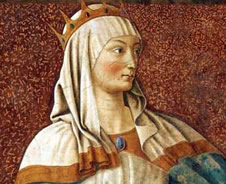 |
Queen
Esther (detail) c 1450, Andrea Del Castagno |
Purim is one of the most joyous festivals in the Jewish calendar. During this festival—celebrated on the fourteenth and fifteenth days of Adar, the twelfth month of the Jewish calendar—believers commemorate the day when, 2,500 years ago, the Jewish people of Persia were saved from extermination.
The story of Purim is told in the Megillah (‘scroll’) of Esther*, which recounts how King Ahasuerus arranged the execution of his queen because she was deemed by his advisors to be disobedient. Esther, an orphan raised by her uncle Mordecai, is chosen to be his new queen, and acting on the advice of her uncle, she keeps her Jewish identity secret.
Soon after, King Ahasuerus appoints an arrogant and power crazed courtier named Haman as his advisor, who passes a law that all must bow before him, a decree Mordecai refuses to obey. Haman is so enraged by this that he convinces the king to decree that all Jews be killed, saying:
“There is a certain people scattered abroad and dispersed among the people in all the provinces of the realm. Their laws are different from those of every other people’s, and they do not observe the king’s laws; therefore it is not befitting the king to tolerate them.” (Esther 3:8)
Mordecai urges Esther to help her people and persuades her to speak to the king. She holds a banquet for the king, during which she reveals that she is a Jew and tells him of Haman’s plot against her people; on hearing this, the king is furious and orders that Haman be killed.
“[Purim] the most boisterous and rowdy of Jewish days, commemorates the first warrant for genocide, Haman’s decree to annihilate the Jewish people. What makes [the festivities] possible is that the decree was averted. In this case, unlike the Holocaust, there was a happy ending.”**
This happy ending—the saving of the Persian Jews—is celebrated during Purim with meals, parties, drinking, masquerades and plays. Jews also visit the synagogue to hear a reading of the Megillah, during which it is customary to make a loud noise whenever Haman is mentioned to drown out the villain’s name.
**From ‘Diary of a Chief Rabbi: Purim’s link to Holocaust’ in London Jewish News and Jewish Telegraph, February 1999. This article also sees an echo of Mordecai’s refusal to obey Haman’s decree in the Jews’ refusal to bow down to Hitler.